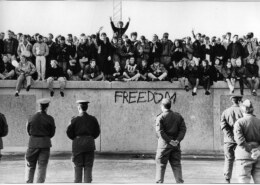On November 9, 1989, the world watched in astonishment as the Berlin Wall — the concrete barrier that had divided East and West Berlin for nearly three decades — finally crumbled. Its fall was more than the physical destruction of a wall; it marked the symbolic end of the Cold War, the collapse of communist regimes across Eastern Europe, and the beginning of a new era of democracy, unity, and globalization.
The Origins of the Berlin Wall
After World War II, Germany was divided into four occupation zones controlled by the United States, the Soviet Union, Britain, and France. Berlin, located deep in the Soviet-controlled zone, was similarly divided. The ideological rivalry between the capitalist West and the communist East soon hardened into the Cold War.
By the late 1950s, millions of East Germans fled to West Berlin in search of political freedom and economic opportunity. To halt this mass exodus, the East German government, backed by the Soviet Union, constructed the Berlin Wall on August 13, 1961. Stretching over 150 kilometers, it became the most visible symbol of division between the Eastern Bloc and the Western world.
Life Under the Wall
The Wall did more than divide a city; it separated families, friends, and communities.
- East Germans lived under strict surveillance, limited freedoms, and economic hardship.
- Attempting to cross the Wall was dangerous and often fatal, with hundreds losing their lives in escape attempts.
- For West Berliners, the Wall was a constant reminder of political repression just beyond their borders.
The Road to Collapse
Several factors contributed to the eventual fall of the Berlin Wall:
- Economic Strain in the East: The Soviet Union and its satellite states faced stagnation, shortages, and growing discontent.
- Reform Movements: Mikhail Gorbachev’s policies of glasnost (openness) and perestroika (restructuring) encouraged calls for freedom.
- Popular Protests: Peaceful demonstrations in East Germany, especially the Leipzig protests, signaled the public’s desire for change.
- Weakening Soviet Grip: Unlike past uprisings, the Soviet Union refrained from using force to suppress dissent.
- Pressure from Neighboring Countries: Hungary and Czechoslovakia opened their borders, allowing East Germans to flee westward.
November 9, 1989: The Wall Falls
Confusion, miscommunication, and mounting public pressure led to the sudden opening of the Wall. An East German official mistakenly announced that travel restrictions were lifted “effective immediately.” Thousands of Berliners rushed to border crossings. Overwhelmed guards opened the gates, and crowds celebrated as people climbed the Wall, danced on top of it, and began dismantling it piece by piece.
Global Impact of the Fall
- End of the Cold War: The Wall’s fall accelerated the collapse of communist regimes across Eastern Europe, culminating in the dissolution of the Soviet Union in 1991.
- German Reunification: Less than a year later, on October 3, 1990, East and West Germany were formally reunified.
- Expansion of Democracy: The event inspired democratic movements worldwide, from Eastern Europe to South Africa.
- Reshaping Global Politics: A unipolar world emerged, with the United States as the dominant power.
- Cultural Legacy: The Berlin Wall remains a powerful symbol of freedom, resilience, and the triumph of unity over division.
Conclusion
The fall of the Berlin Wall was more than a turning point for Germany; it was a defining moment in world history. It signified the end of an era of division and the dawn of new possibilities for global cooperation and peace. While new challenges have since emerged, the memory of November 9, 1989, continues to remind the world that even the most rigid barriers can crumble under the weight of human aspiration for freedom and unity.

